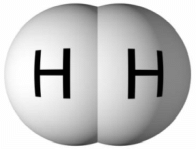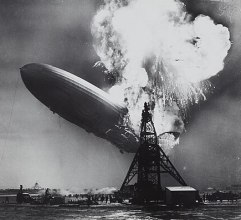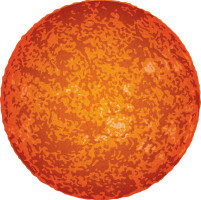  Hydrogen is the most abundant element in the universe. Each atom has only one proton, making its atomic number 1 on the Periodic Table. Hydrogen gas is made from two hydrogen atoms bound together, H2.
Hydrogen is the most abundant element in the universe. Each atom has only one proton, making its atomic number 1 on the Periodic Table. Hydrogen gas is made from two hydrogen atoms bound together, H2.The Sun, and other stars, are essentially giant balls of hydrogen and helium, with the hydrogen undergoing fusion into helium gas. This process causes the Sun to produce vast amounts of energy. Hydrogen is a colourless, odourless, tasteless, and highly flammable gas that is the simplest member of the family of chemical elements. Hydrogen does not occur naturally on Earth, but is present in compounds with other elements in liquids, gases and solids. For example, hydrogen combined with oxygen is water (H2O). Hydrogen combined with carbon forms compounds called hydrocarbons that are found in natural gas, coal, and petroleum. On Earth hydrogen occurs in vast quantities as part of water in oceans, ice packs, rivers, lakes, and the atmosphere. It is also part of a host of carbon compounds, and present in all animal and vegetable tissue. Hydrogen can be used as a fuel. It has the highest energy content of any common fuel by weight, about three times more than gasoline. It takes more energy to produce hydrogen than hydrogen provides when it is converted to useful energy. However, hydrogen is still useful as a fuel because it has a high energy content per unit of weight, which is why it is used as a rocket fuel and in fuel cells to produce electricity. Hydrogen is not widely used as a fuel yet, but it has the potential for greater use in the future. Because hydrogen typically does not exist freely in nature and is produced from other sources, it is known as an energy carrier. It is a clean-burning fuel, and when combined with oxygen in a fuel cell, hydrogen produces heat and electricity with only water vapour as a by-product.  Hydrogen can also be made by doing the reverse reaction to a fuel cell using a device called an electrolyser. This uses electricity to split water into hydrogen and oxygen. You can try a simple demonstration that will let you perform electrolysis of water on a small scale.  The Hindenburg disaster was an airship accident that occurred in 1937 in New Jersey, U.S.
The Hindenburg was a commercial passenger-carrying airship.
Filled with hydrogen, it caught fire and was destroyed during its attempt to dock with its mooring mast
The accident caused 35 fatalities among the 97 people on board, including one person on the ground.
The Hindenburg disaster was an airship accident that occurred in 1937 in New Jersey, U.S.
The Hindenburg was a commercial passenger-carrying airship.
Filled with hydrogen, it caught fire and was destroyed during its attempt to dock with its mooring mast
The accident caused 35 fatalities among the 97 people on board, including one person on the ground.The publicity from the disaster destroyed public confidence in rigid airships, and marked the end of the airship era. Modern blimps, like the Goodyear Blimp, are filled with helium which, while expensive and not providing as much lift as hydrogen, is non-flammable and safe.  Nuclear fusion is a reaction in which two or more atomic nuclei, usually deuterium and tritium (hydrogen isotopes), combine to form different atomic nuclei, such as helium. This combining only occurs when there is a massive amount of pressure and heat, as in the centre of a star. The reaction is accompanied by the release of tremendous amounts of energy.
Nuclear fusion is a reaction in which two or more atomic nuclei, usually deuterium and tritium (hydrogen isotopes), combine to form different atomic nuclei, such as helium. This combining only occurs when there is a massive amount of pressure and heat, as in the centre of a star. The reaction is accompanied by the release of tremendous amounts of energy. This energy can also be released by fusion in a hydrogen bomb. |